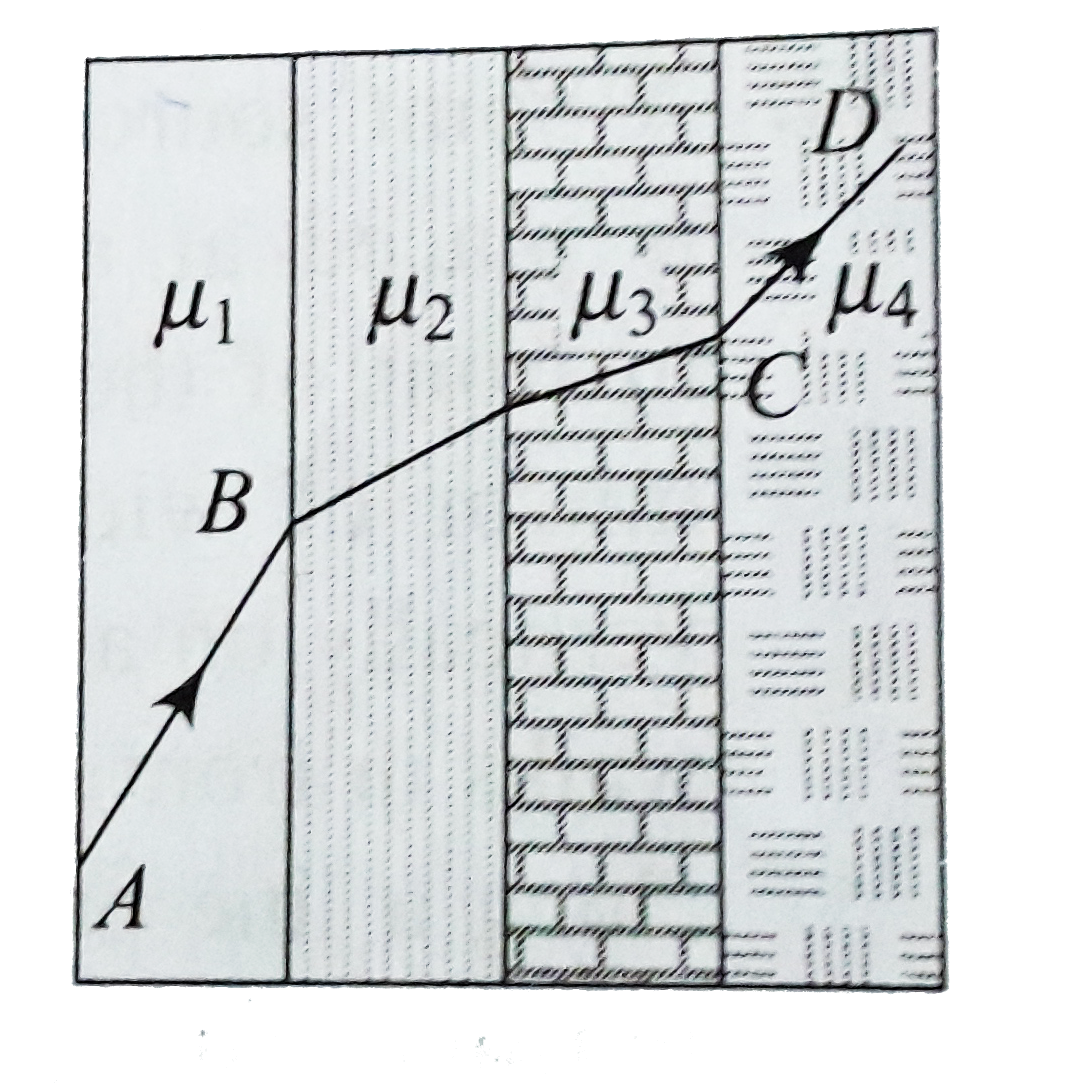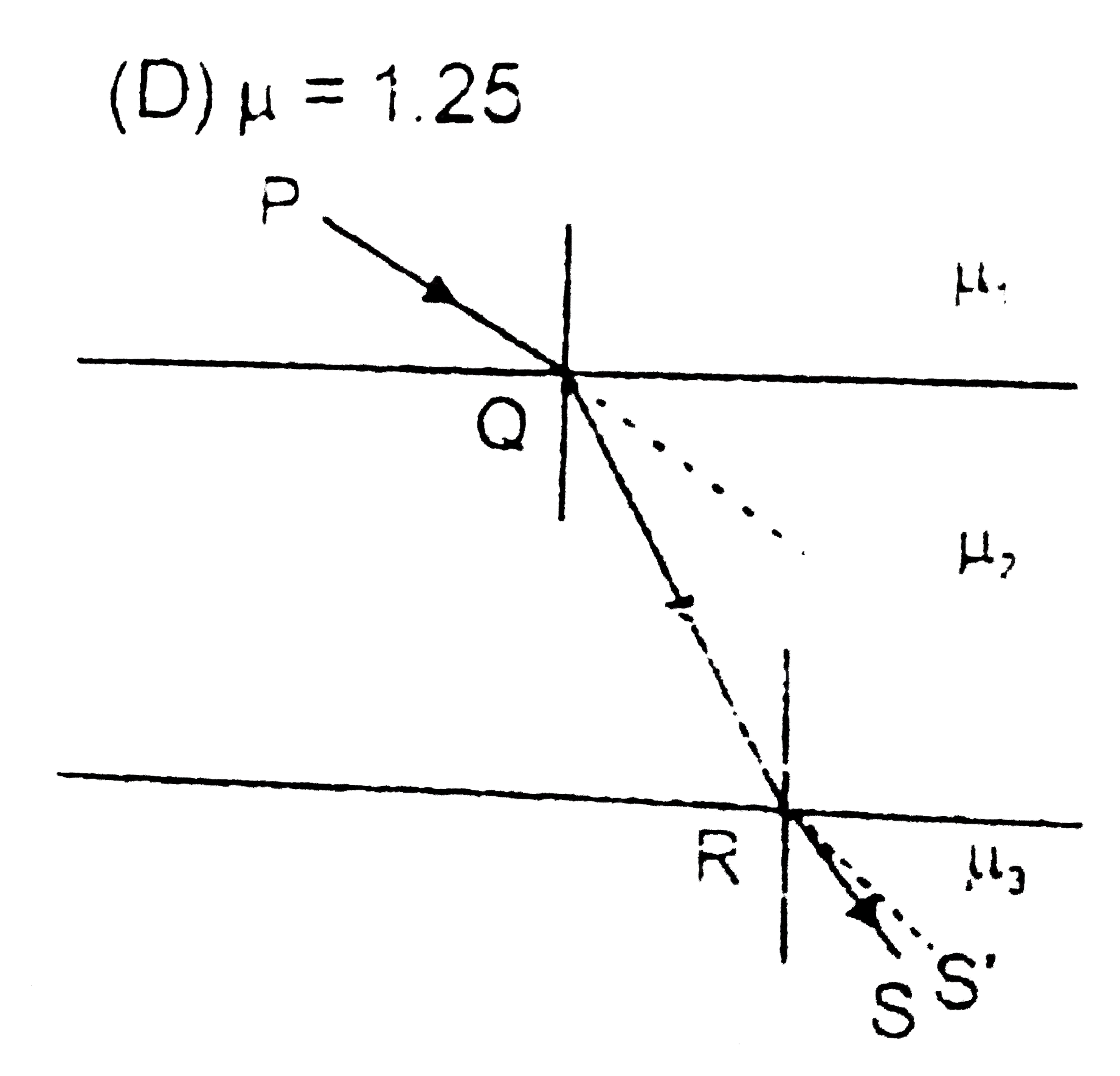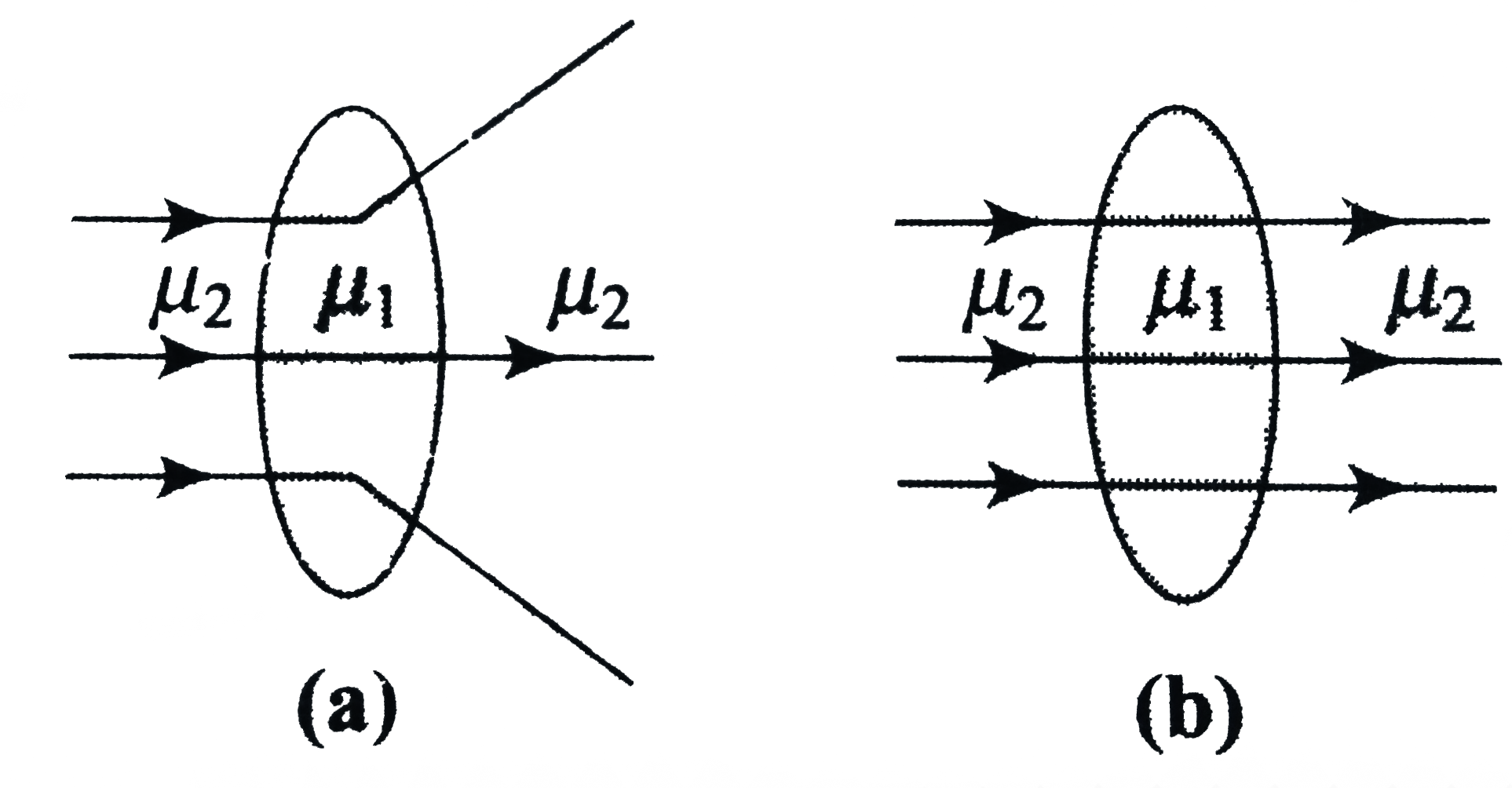There are three optical media 1,2 and 3 with the refractive indices μ1>μ2>μ3.
(TIR → total internal reflection)
when a ray of light travels from 3 to 1 no TIR will place
critical angle between 1 and 2 is less than the critical angle between 1 and 3
critical angle between 1 and 2 is more than the critical angle between 1 and 3
chances of TIR are move when ray of light travels from 1 to 3 as compared to the case when it travel from 1 to 2
The correct Answer is:A, C, D
To solve the question regarding total internal reflection (TIR) in three optical media with different refractive indices, we will analyze the conditions for TIR and the critical angles between the media.
1. Understanding Refractive Indices:
Given three media with refractive indices μ1>μ2>μ3, we know that medium 1 is the densest and medium 3 is the rarest.
2. Conditions for Total Internal Reflection (TIR):
- TIR occurs when light travels from a denser medium to a rarer medium.
- The angle of incidence must be greater than the critical angle θc for TIR to occur.
3. Critical Angle Calculation:
The critical angle θc between two media can be calculated using the formula:
sin(θc)=n2n1
where n1 is the refractive index of the denser medium and n2 is that of the rarer medium.
4. Analyzing Each Option:
Option A: "When a ray of light travels from 3 to 1, no TIR will take place."
- Since light is moving from a rarer medium (3) to a denser medium (1), TIR cannot occur. This statement is true.
Option B: "The critical angle between 1 and 2 is less than the critical angle between 1 and 3."
- The critical angle between 1 and 2 (θc1,2) will be greater than that between 1 and 3 (θc1,3) because μ2<μ3. Hence, this statement is false.
Option C: "The critical angle between 1 and 2 is more than the critical angle between 1 and 3."
- This is the reverse of option B. Since μ1>μ2>μ3, it follows that θc1,2>θc1,3. This statement is true.
Option D: "Chances of TIR are more when a ray of light travels from 1 to 3 as compared to when it travels from 1 to 2."
- Since the critical angle for 1 to 3 is smaller than that for 1 to 2, the chances of TIR are indeed higher when light travels from 1 to 3. This statement is true.
5. Final Conclusion:
The true statements are A, C, and D.
Summary of Answers:
- True Statements: A, C, D
- False Statement: B
Given three media with refractive indices μ1>μ2>μ3, we know that medium 1 is the densest and medium 3 is the rarest.
- TIR occurs when light travels from a denser medium to a rarer medium.
- The angle of incidence must be greater than the critical angle θc for TIR to occur.
The critical angle θc between two media can be calculated using the formula:
sin(θc)=n2n1
where n1 is the refractive index of the denser medium and n2 is that of the rarer medium.
- Since light is moving from a rarer medium (3) to a denser medium (1), TIR cannot occur. This statement is true.
- The critical angle between 1 and 2 (θc1,2) will be greater than that between 1 and 3 (θc1,3) because μ2<μ3. Hence, this statement is false.
- This is the reverse of option B. Since μ1>μ2>μ3, it follows that θc1,2>θc1,3. This statement is true.
- Since the critical angle for 1 to 3 is smaller than that for 1 to 2, the chances of TIR are indeed higher when light travels from 1 to 3. This statement is true.
The true statements are A, C, and D.
- True Statements: A, C, D
- False Statement: B
Topper's Solved these Questions
- RAY OPTICSBOOK - DC PANDEY ENGLISHCHAPTER - RAY OPTICSEXERCISE - C. comprehension type question
14 Videos
- RAY OPTICSBOOK - DC PANDEY ENGLISHCHAPTER - RAY OPTICSEXERCISE - Matrix matching type Q.
8 Videos
- RAY OPTICSBOOK - DC PANDEY ENGLISHCHAPTER - RAY OPTICSEXERCISE - A. Only one option is correct (JEE Advance)
73 Videos
- PROPERTIES OF MATTERBOOK - DC PANDEY ENGLISHCHAPTER - PROPERTIES OF MATTEREXERCISE - Integer
8 Videos
- ROTATIONBOOK - DC PANDEY ENGLISHCHAPTER - ROTATIONEXERCISE - (C) Chapter Exercises
39 Videos
Similar Questions
There are three optical media 1,2 and 3 with their refractive index μ1, μ2 and μ3 such that μ1>μ2>μ3 choose the correct options (TIR means total internal reflection)
View SolutionA ray of light passes through four transpar ent media with refractive indicesμ1,μ2,μ3 and μ4 as shown in figure. The surfaces of all media are parallel. If the emergent ray is parallel to the incident ray, we must hav

View Solution
Knowledge Check
Three immiscible liquids of densities d1>d2>d3 and refractive indices μ1>μ2>μ3 are put in a beaker. The height of each liquid column is h3. A dot is made at the bottom of the beaker. For near normal vision, find the apparent depth of the dot.
Ah6(1μ1+1μ2+1μ3)Bh6(1μ1−1μ2−1μ3)Ch3(1μ1−1μ2−1μ3)Dh3(1μ1+1μ2+1μ3)
The x-z plane separates two media A and B of refractive indices μ1=1.5 and μ2=2. A ray of light travels from A to B. Its directions in the two media are given by unit vectors u1=aˆi+bˆj and u2=cˆi+aˆj. Then
View SolutionA ray of light passes through four transparent media with refractive indices μ1,μ2,μ3,andμ4 as shown in figure. The surfaces of all media are paralle. If the emerent ray CD is parallel to the incident ray AB, we must have

View SolutionObtain an expression for refraction at a single convex spherical surface separating the two media having refractive indices μ1(rarer medium) and μ2(denser medium) i.e., a relation between u,v,μ1,μ2 and R.
View SolutionLight is incident normally on face AB of a prism as shown in Figure. A liquid of refractive index μ is placed on face AC of the prism. The prism is made of glass of refractive indes 3/2 . Find the limits of μ for which total internal reflection takes place on the face AC.
(A)μ>√32 (B)3√34>μ (C)μ>√3 (D)μ<√32
View SolutionIf the figure below, PQRS denotes the path followed by a ray of light as it travels three media in succession. The absoulte refractive indices of the media are μ1,μ2 and μ3 respectively (The line segment RS' in the figure is parallel to PQ) Then :
 .
.
View SolutionThree immiscible liquids of densities d1>d2>d3 and refractive indices μ1>μ2>μ3 are put in a beaker. The height of each liquid column is h3. A dot is made at the bottom of the beaker. For near normal vision, find the apparent depth of the dot.
View SolutionWhat is the relation between the refractive indicesμ,μ1 and μ2 if the behaviour of light rays is shown in Figure.

View Solution
